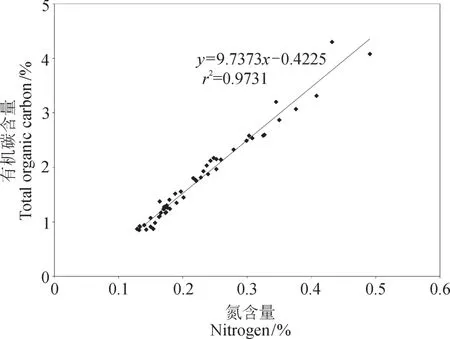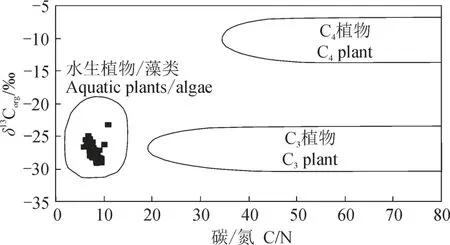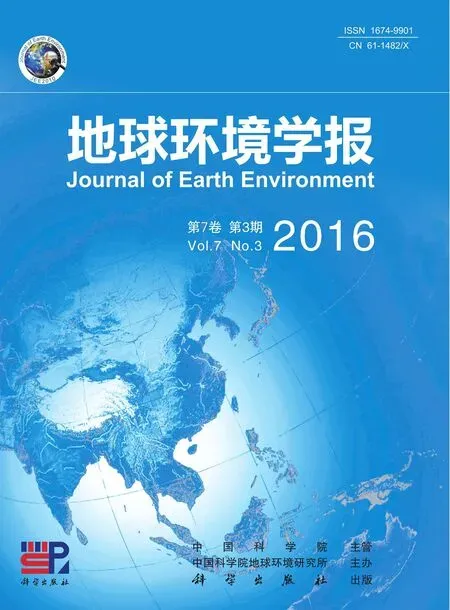湖泊沉积多指标记录的长寿湖近60年来营养化过程
朱正杰,肖 军,龚业超,杨洪永,张 雄 双 燕,毛玲玲
(1. 外生成矿与矿山环境重庆市重点实验室 重庆地质矿产研究院,重庆 400042;2. 煤炭资源与安全开采国家重点实验室重庆研究中心,重庆 400042;3.中国科学院地球环境研究所 黄土与第四纪地质国家重点实验室,西安 710061)
湖泊沉积多指标记录的长寿湖近60年来营养化过程
朱正杰1,2,肖 军3,龚业超1,杨洪永1,张 雄1, 双 燕1,毛玲玲1
(1. 外生成矿与矿山环境重庆市重点实验室 重庆地质矿产研究院,重庆 400042;2. 煤炭资源与安全开采国家重点实验室重庆研究中心,重庆 400042;3.中国科学院地球环境研究所 黄土与第四纪地质国家重点实验室,西安 710061)
长寿湖位于重庆市长寿区境内,是重庆市最大的湖泊旅游风景区和淡水鱼养殖基地之一。近年来,其营养化日趋严重。本文通过对有机质碳、氮含量、碳氮比值、有机质碳同位素等有机质指标的分析,结合137Cs放射性核素定年,探讨了长寿湖近60年来有机质转化及营养演化过程。结果表明:长寿湖有机质主要来源于水生植物藻类,受陆源影响较小;湖泊环境演化分为两个截然不同的阶段:1980年以前,有机质碳、氮含量较低,C / N比值较小,有机质碳同位素值较大,暗示湖泊营养环境为贫营养化。1980年以后,有机质碳、氮含量较高,C / N比值较大,有机质碳同位素值偏负,说明湖泊已经处于营养化阶段,人为活动的增强及养殖业的发展是导致湖泊生产力增大的主要因素。长寿湖沉积物多指标忠实记录了湖泊环境的演化过程。
长寿湖;有机质碳同位素;营养化;人为活动
长寿湖是重庆市最大的湖泊旅游风景区和重要的淡水鱼养殖基地之一。自20世纪80年代以来,随旅游业、养殖业蓬勃发展,长寿湖已成为集饮用、灌溉、旅游、养殖、发电为一体的多功能水体。近年来,城市污水和工业废水排放量渐增,大部分流入长寿湖区,严重影响其水质。湖区“水华”现象引起社会各界广泛重视(杨钢等,2003)。对长寿湖表层沉积物氮磷研究发现:其TN平均含量为2255.89 mg·kg-1,TP平均含量为622.03 mg·kg-1,湖区氮磷污染严重。长寿湖表层沉积物中有机氮是总氮的主要组成部分,占总氮的97.16 %(卢少勇等,2012)。杨钢等(2003)对长寿湖水质的营养状况进行了综合评价,结果表明长寿湖水质已呈中度富营养化状态,有向富营养化发展的潜在趋势。胡鹏飞和何太蓉(2012)对长寿湖表层沉积物中的氮赋存特征进行了研究,认为长寿湖表层沉积物污染已较严重;同时,他们还对长寿湖表层沉积物中磷的赋存状态进行了研究,结果显示长寿湖表层沉积物具有很强的释磷潜力,长寿湖沉积物呈中度污染,应加强监测和治理。目前,人们对湖泊富营养化的认识主要是通过水质和表层沉积物的调查(杨钢等,2003;郭海涛等,2011;胡鹏飞和何太蓉,2012;卢少勇等,2012),这种方法无法追踪历史时期湖泊的富营养化过程,特别是在缺乏长期湖泊监测记录的情况下,对湖泊发生富营养化程度的拐点、富营养化速率、发展趋势并不清楚。对湖泊富营养化过程的了解有利于控制和采取措施抑制湖泊的进一步营养化。湖泊沉积物,是湖泊生态系统的重要组成部分,是入湖物质如有机质、污染物等的主要储蓄所,包含了丰富的生物和理化方面的信息,通过湖泊沉积剖面的环境代用指标的研究,可以了解湖泊及流域的污染状况,重建湖泊环境变化的历史过程。
湖泊沉积物有机质代用指标如碳同位素、碳氮含量在湖泊环境演化及富营养化过程示踪研究方面的应用日益深入。有机质C/N 比值和碳同位素能有效判断湖泊沉积物有机质来源(Meyers,1997),同时湖泊有机质碳同位素组成及有机质碳氮含量是湖泊生产力变化的有效代用指标,从而指示湖泊营养状况。基于对长寿湖区域环境演变及营养化过程的了解为目的,本文通过对长寿湖沉积物柱芯中有机质碳氮含量、C/N比值、有机质碳同位素等多指标的分析,结合精确的放射性核素137Cs定年,探讨了长寿湖近60年湖泊沉积物有机质转化及环境演化过程,以期为合理治理长寿湖营养化提供依据。
1 湖区概况
长寿湖位于重庆市长寿区境内,地理坐标为北纬29°50′ — 30°04′,东经107°15′ — 107°25′,是狮子滩水电站拦河大坝建成以后形成的人工淡水湖,是我国西南地区最大的人工淡水湖,也是重庆市最大的湖泊旅游风景区和国家级生态旅游休闲度假区。长寿湖水域面积约65.5 km2,平均水深15 m,最大水深40 m,是重庆市重要的淡水养殖基地。
2 样品采集和实验方法
使用重力采样器于2013年10月在长寿湖深水区采得两根沉积物柱芯,编号为CS1和CS2,长度分别为50 cm和49 cm,采样点远离湖岸,覆水深25 m。所采沉积物柱芯保存完好,悬浮层未受扰动,界面水清晰。沉积物柱芯现场按1 cm间隔分截样品装入塑料自封袋中密闭保存。CS1和CS2柱芯样品运回实验室,经真空冷冻干燥器(型号:FD-IA-50)干燥后,用玛瑙研钵研磨至200目以下备用。CS1柱芯样品用于有机质指标测定,包括有机碳、氮含量和有机质碳同位素,CS2柱芯样品用于放射性核素137Cs比活度测定。
2.1 放射性核素137Cs测定
137Cs的比活度采用Caberra公司生产的S-100多道能谱仪进行γ-谱测定,根据样品量情况,分别用GC5019同轴锗探测器(探测器效率50%)或GCW井型锗探测器(探测器效率30%)。137Cs计数峰的位置为661.6 k eV,测量误差<5%。
2.2 元素含量分析方法
有机质碳、氮含量及C/N比值测定采用前处理方法如下:称取样品3 g,加入0.5 M的HCl溶液25 mL,在水浴锅60℃中反应2 h,去除碳酸盐,后用氧水洗净,冷冻干燥后利用元素分析仪(PE2400Ⅱ型)测定有机质碳、氮含量及C/N比值,分析误差小于5 %。
2.3 有机质碳同位素分析方法
将沉积物0.5 g放入50 mL离心管中,加入0.5 M的HCl溶液25 mL,在水浴锅60℃中反应2 h,去除碳酸盐,后用氧水洗净,冷冻干燥后以备有机质碳同位素测定。有机质碳同位素测定采用连续流质谱,仪器型号为EA IsoPrime,以国际纤维素标样IAEA-C3(δ13C = -24.91‰)为参考标准校正分析结果。测量误差小于0.1‰,结果采用PDB标准。

图1 长寿湖位置示意图及采样点位图Fig.1 Location of Lake Changshou and sampling site
δ13C计算公式为:

以上所有实验均在中国科学院地球化学研究所环境地球化学国家重点实验室完成。
3 分析结果
3.1 沉积物柱芯年代的确定
由于长寿湖是人工湖泊,其形成年代较短,因此利用137Cs测年是比较合理的方法。137Cs是人类活动(核试验)释放后通过大气扩散而沉降到地表的放射性核素,广泛用于湖泊现代沉积计年的研究(白占国和万国江,1998)。从长寿湖沉积物137Cs比活度图上可以看出,剖面上出现一个明显峰值(图2),深度为36 cm,这个峰值被认为是1963年全球性核试验高峰期(Wan et al,1987)。全球核试验的初始时间是20世纪50年代初期,而散落的高峰期是1963 — 1964年(Wan et al,1987)。因此利用137Cs散落峰的时间和沉积深度可以获得沉积物堆积速率,平均堆积速率为0.85 cm·a-1,依据此速率从而建立起长寿湖沉积物年代标尺。此外,利用137Cs测年所获得沉积物底部年龄为1943 AD,与长寿湖建于20世纪40年代比较吻合。

图2 长寿湖沉积物CS2柱芯137Cs比活度剖面变化图Fig.2 Diagram of137Cs activities in Lake Changshou sediments
3.2 有机质碳、氮含量特征
长寿湖沉积物柱芯TOC含量在0.85% — 4.30%波动,平均值为1.79‰,最大变幅为3.45%(图3);从有机碳含量曲线变化特征来看,1980年以前TOC平均值为1.25%,1980年以后TOC平均值为2.43%,表现出显著增高的特征;TN含量变化范围为0.13% — 0.49%,平均值为0.23%,最大变幅为0.36%(图3),其变化特征与TOC含量变化特征极为相似,以1980年为时间拐点,1980年以后TN含量显著增高。此外,TOC与TN呈显著相关性变化(图4),相关系数接近1,一方面表明这两者均与有机质有关,同时也说明长寿湖沉积物中N的含量主要以有机氮为主,沉积物有机质来源单一,与前人研究结果(卢少勇等,2012)一致。卢少勇等(2012)的研究认为长寿湖沉积物中有机氮是总氮的主要组成部分,占总氮97.16%。TOC/N值变化范围为6.61 — 11.62,平均值为8.92 (图3),TOC/N显示了与TOC、TN相同的变化特征,在1980年以后TOC/N含量显著增大。
3.3 有机质碳同位素变化特征
长寿湖沉积物柱芯有机质碳同位素值的变化范围为-22.48‰ — -28.23‰,平均值为-26.66%(图3)。其变化特征显示了与TOC、N、TOC/N截然相反的变化特征,在1980年以后有机质碳同位素值显著偏负。

图3 长寿湖沉积物CS1柱芯有机质碳、氮含量、C/N比值及有机质碳同位素值随年代变化特征Fig.3 Evolution of organic carbon, nitrogen content, C/N ratios and organic carbon isotope values in sediment core CS1 at Lake Changshou
4 讨论
4.1 长寿湖有机质来源
一般认为,湖泊水生植物含有较多的蛋白质,其C/N值小于10;陆生植物富含腐殖质,其C/ N值较大,在20 — 200(Krishnamurthy et al,1986;Lamb et al,2004)。
湖泊沉积物有机质的陆源和内源具有完全不同的δ13C值。陆源植物按其光合作用途径分为C3、C4和CAM三种类型。如果光合作用的最初产物为四碳二羟酸,则相应植物称为C4植物,C4植物δ13C值为-9‰ — -21‰,平均为-14‰;如果光合作用的最初产物为三磷酸甘油酯,则相应植物称为C3植物,C3植物δ13C值较低,一般为-21‰ — -33‰,平均为-27‰。CAM植物类型较少(例如仙人掌科),其典型生境为干旱环境,δ13C值变化范围较大。浮游植物由于其吸收水中溶解CO2,与大气CO2处于同位素平衡,所以其同位素组成与C3植物相似。

图4 长寿沉积物柱芯有机质碳、氮含量的相关性图Fig.4 The correlation between organic carbon and nitrogen content at Lake Changshou
因此,湖泊沉积物有机质C/N比结合其碳同位素组成(δ13Corg)是判断有机质来源的有效手段(Meyers and Ishiwatari,1993;Meyers,1994,1997)。长寿湖沉积物有机质C/N比和δ13Corg值显示其主要来源于水生植物和藻类(图5),基本不受或受陆源物质影响较小。
4.2 指标的环境指示意义
自从Stuiver(1975)首次使用湖泊沉积物有机质碳同位素(δ13Corg)恢复湖泊生产力变化以来,有机质碳同位素被广泛应用于古气候和古环境重建(Stuiver,1975; Mckenzie,1985;Schelske and Hodell,1991;Mayer and Schwark,1999;Leng and Marshall,2004;Xu et al,2006;Henderson and Holmes,2009;赵艳等,2013;Zhu et al,2013)。湖泊沉积物有机质碳同位素的变化可能受以下过程的影响:(1)不同来源碳的相对含量变化(陆源植物和水生植物具有不同的碳同位素组成);(2)内源为主的湖泊,受湖水溶解无机碳(DIC)的碳同位素组成控制(Hodell and Smith,2001)。在内源有机质为主的湖泊中,沉积物有机质碳同位素主要用来判断历史时期湖泊生产力变化。众多研究者建立了湖泊沉积物有机质δ13C随湖泊初级生产力变化的响应模式(Schelske and Hodell,1991;McKenzie and Hollander,1993;Meyers,1997;Teranes et al,1999;Teranes and McKenzie,1999;Teranes and Bernasconi,2005),即随着湖泊初级生产力的逐渐增大,使得水体中可利用CO2减少,水生植物倾向于吸收湖水溶解无机碳(DIC)中作为碳源。由于的δ13C值比可溶解CO2的δ13C偏正(Meyers,1997;Leng and Marshall,2004;Xu et al,2006),从而导致有机质δ13C值偏正;反之,随着湖泊初级生产力的逐渐减小,有机质δ13C偏负。

图5 长寿湖沉积物C/N比值和δ13Corg示意图不同来源有机质C/N比和δ13Corg值引自Mayers and Ishiwatari,1993;Meyers,1994,1997。Fig.5 C / N ratios andδ13Corgvalues of sedimentary organic matter from Lake Changshou General C/N ratios andδ13Corgranges for aquatic plants and C3/C4land plants cited from Mayers and Ishiwatari, 1993; Meyers, 1994, 1997.
4.3 多指标记录的环境演化
根据长寿湖沉积物柱芯有机质C、N含量、C/N比值及有机质碳同位素综合来看(图3),长寿湖近60年来的演化过程可以分为两个阶段,以1980年为时间拐点:(1)1980年以前的湖泊自然演化的贫营养特征。有机质碳、氮含量较低,C/N比值较小,δ13Corg值较大且变化稳定,说明长寿湖从湖泊形成到1980年这段时间内属于自然演化过程,各有机质指标均比较稳定,变化较小;(2)1980年以后的营养化阶段。有机质C、N含量、C/N比值及无机碳含量均呈现显著增大过程,C/N比值增大说明长寿湖在1980年以后有少量陆源植物的输入,δ13Corg值的显著偏负暗示湖泊有机质来源仍然以藻类为主。
长寿湖近60来的环境演化过程的转换期为1980年。1980年以前长寿湖为自然演化过程,湖泊生产力水平低下,湖泊处于稳定状态。1980年以后所有指标均呈现出显著变化特征,说明湖泊已经处于营养化状态。事实上,自20世纪80年代以来,随旅游业、养殖业蓬勃发展,长寿湖已成为集饮用、灌溉、旅游、养殖、发电为一体的多功能水体。伴随着旅游业和养殖业的快速发展,严重影响了长寿湖的区域环境,内源物质的逐渐积累,导致湖泊生产力的增大;湖区偶尔爆发的“水华”现象说明了其湖泊生态环境已遭到破坏(杨钢等,2003)。近60年来长寿湖沉积物有机质多指标反映的环境演化特征与人类活动显示了一致的变化过程,忠实记录了长寿湖从自然演化环境逐步过渡到富营养化的过程。
从图3a、3c、3d可以看出,长寿湖沉积物有机质碳同位素值随着有机质碳、氮含量的增加而减小;而传统的研究认为湖泊初级生产力的逐渐增大,导致有机质δ13C值增大。随着湖泊生产力的提高,导致有机质碳同位素值偏负的原因可能有:(1)同位素的非平衡沉淀。有研究结果认为湖泊营养化过程的同位素非平衡沉淀导致有机质δ13C值偏负(Fronval et al,1995;Teranes and McKenzie,1999;吴敬禄等,2002;Wu et al,2004;Teranes and Bernasconi,2005);(2)藻类吸收的CO2来源会受到湖泊环境制约而改变。营养化初级阶段湖泊生产力得到提高,藻类吸收的CO2部分来源于大气CO2,随着营养化加剧,藻类发育,水中溶解的CO2与大气CO2的交换平衡被打破,水体中溶解的CO2已经不能满足藻类生长的需要,有机质降解作用产生的CO2逐渐被藻类吸收,导致有机质碳同位素组成偏负(周志华等,2007;Zhu et al,2011)。一般认为同位素的非平衡沉淀发生在特别富营养化的湖泊中(Wu et al,2004),而长寿湖显然没有达到超级富营养化阶段。因此,可以认为长寿湖沉积物有机质碳同位素值随着湖泊生产力的增大而偏负的原因主要是藻类吸收偏负的同位素所致。周志华等(2007)在研究巢湖时也发现随着巢湖富营养化过程的进一步加剧,其有机质碳同位素逐渐偏负。Zhu et al(2011)研究了不同水生植物类型湖泊,沉积物有机质δ13C值与湖泊初级生产力变化的响应过程,认为大型水草为主的湖泊(如草海),其沉积物有机质δ13C值随湖泊生产力的增大呈现增加的变化趋势;藻类为主的湖泊(巢湖、程海、长寿湖等),其沉积物有机质δ13C随湖泊生产力的增大呈现减小的变化趋势,藻类易降解是导致δ13C值随湖泊生产力的增大呈现减小变化趋势的主要原因(周志华等,2007)。因此,长寿湖富营养化过程中藻类发育及藻类易降解是导致其沉积物有机质δ13C值随湖泊生产力的增大呈现减小趋势的主要原因。
5 结论
(1)长寿湖沉积物有机质C/N比和δ13Corg值表明长寿湖沉积物有机质主要源于水生植物和藻类,基本不受或受陆源物质的影响较小。
(2)近60年来长寿湖沉积物有机质多指标反映的环境演化特征与人类活动影响一致,忠实记录了长寿湖从自然演化环境逐步过渡到富营养化的过程。1980年以前长寿湖为自然演化过程,湖泊生产力水平低下,湖泊处于稳定状态;1980年以后所有指标均呈现了显著的变化特征,说明湖泊已经处于营养化状态。长寿湖沉积物有机质碳同位素值随着有机质碳、氮含量的增加而减小与传统的研究认为湖泊初级生产力的逐渐增大导致有机质δ13C值增大不一致,湖泊营养化过程中藻类发育及藻类易降解是导致长寿湖有机质δ13C值随湖泊生产力增大呈现减小趋势的主要原因。长寿湖营养化过程的逐渐加剧提醒人们需要对其进行监管和采取有效防治措施。
白占国, 万国江. 1998. 现代侵蚀作用核素示踪研究新进展[J].地球科学进展, 13: 232 – 237. [Bai Z G, Wan G J. 1998. Progress in the study of the soil erosion using radionuclides [J].Advance in Earth Science, 13: 232 – 237.]
郭海涛, 张进忠, 魏世强, 等. 2011. 长寿湖沉积物中磷形态的季节变化特征[J].环境科学, 32: 1994 – 1999. [Guo H T, Zhang J Z, Wei S Q, et al. 2011. Seasonal variation characteristics of phosphorus speciation in the sediments of Changshou Lake [J].Environmental Sciences, 32: 1994 – 1999.]
胡鹏飞, 何太蓉. 2012. 长寿湖表层沉积物中氮的赋存状态及污染评价[J].水土保持研究, 19: 163 – 167. [Hu P F,He T R. 2012. Forms and pollution assessment of nitrogen in surface sediments of Changshou Lake [J].Research of Soil and Water Conservation, 19: 163 – 167.]
卢少勇, 许梦爽, 金相灿, 等. 2012. 长寿湖表层沉积物氮磷和有机质污染特征及评价[J].环境科学, 33: 393 – 398. [Lu S Y, Xu M S, Jin X C, et al. 2012. Pollution characteristics and evaluation of nitrogen, phosphorus and organic matter in surface sediments of Lake Changshou in Chongqing, China [J].Environmental Sciences, 33: 393 – 398.]
吴敬禄, 蒋雪中, 夏威岚, 等. 2002. 云南程海近500年来湖泊初始生产力演化[J].海洋地质与第四纪地质, 22: 71 – 75. [Wu J L, Jiang X Z, Xia W L, et al. 2002. Climate and primary productivity over the past 500 years of the Chenghai Lake, Yunnan [J].Marine Geology and Quaternary Geology, 2002, 22(2): 71 – 75.]
杨 钢, 张 晟, 李崇明, 等. 2003. 重庆长寿湖水质富营养化的调查及评价[J].西南师范大学学报(自然科学版), 28: 492 – 495. [Yang G, Zhang S, Li C M, et al. 2003. Evaluation and investigation of water eutrophication in Changshou Lake [J].Journal of Southwest China Normal University (Natural Science), 28: 492 – 495.]
赵 艳, 吴福莉, 迟云平. 2013. 总有机碳同位素组成在古环境中的应用[J].地球环境学报, 4(6): 1519 – 1530. [Zhao Y, Wu F L, Chi Y P. 2013. Application of bulk organic carbon isotope composition for paleoenvironmental research [J].Journal of Earth Environment, 4(6): 1519 – 1530.]
周志华, 刘丛强, 李 军, 等. 2007. 巢湖沉积物δ13Corg和δ15N记录的生态环境演化过程[J]. 环境科学, 28: 1338 – 1343. [Zhou Z H, Liu C Q, Li J, et al. 2007. Record of ecosystem evolvement process provided byδ13Corgandδ15N values in Chaohu Lake sediments [J].Environmental Sciences, 28: 1338 – 1343.]
Fronval T, Jensen N, Buchardt B. 1995. Oxygen isotope disequilibrium precipitation of calcite in Lake Arresø, Denmark [J].Geology, 23: 463 – 466.
Henderson A C G, Holmes J A. 2009. Palaeolimnological evidence for environmental change over the past millennium from Lake Qinghai sediments: A review and future research prospective [J].Quaternary International, 194: 134 – 147.
Hodell D J, Smith M A. 2001. Microbially mediated carbon cycling as a control on theδ13C of sedimentary carbon in eutrophic Lake Mendota (USA): New models for interpreting isotopic excursions in the sedimentary record [J].Geochimica et Cosmochimica Acta, 65: 4321 – 4337.
Krishnamurthy R V, Bhattacharya S K, Kusumgar S. 1986. Palaeoclimatic changes deduced from13C/12C and C/N ratios of Kaeewa lake sediments, India [J].Nature, 323: 150 – 152.
Lamb A L, Leng M J, Mohammed M U, et al. 2004. Holocene climate and vegetation changes in the Main Ethiopian Rift Valley, inferred from the composition (C/N andδ13C) of lacustrine organic matter [J].Quaternary Science Reviews, 23: 881 – 891.
Leng M J, Marshall J D. 2004. Palaeoclimate interpretation of stable isotope data from lake sediment archives [J].Quaternary Science Reviews, 23: 811 – 831.
Mayer B, Schwark L. 1999. A 15,000-year stable isotope record from sediments of Lake Steisslingen, southwest Germany [J].Chemical Geology, 161: 315 – 337.
McKenzie J A, Hollander D J. 1993. Oxygen-isotope record in recent carbonate sediments from lake Greifen, Switzerland (1750 — 1986): Application of continental isotopic indicator for evaluation of changes in climate and atmospheric circulation patterns, climate change in continental isotopic records [J].Geophysical Monograph, 78: 101 – 111.
McKenzie J A. 1985. Carbon isotopes and productivity in the lacustrine and marine environment [M]// Stumm W. Chemical processes in lakes. New York: Wiley: 99 – 118.
Meyers P A, Ishiwatari R. 1993. Lacustrine organic geochemistry — an overview of indicators of organic matter sources and diagenesis in lake sediments [J].Organic Geochemistry, 20: 867 – 900.
Meyers P A. 1994. Preservation of elemental and isotope source identifi cation of sedimentary organic matter [J].Chemical Geology, 114: 289 – 302.
Meyers P A. 1997. Organic geochemical proxies of paleoceanographic, paleolimnologic, and paleoclimatic processes [J].Organic Geochemistry, 27: 213 – 250.
Schelske C L, Hodell D A. 1991. Recent changes in productivity and climate of Lake Ontario detected by isotopic analysis of sediments [J].Limnology andOceanography, 36: 961 – 975.
Stuiver M. 1975. Climate versus changes in13C content of the organic component of lake sediments during the Quaternary [J].Quaternary Research, 5: 251 – 262.
Teranes J L, Bernasconi S M. 2005. Factors controllingδ13C values of sedimentary carbon in hypertrophic Baldeggersee, Switzerland, and implications for interpreting isotope excursions in lake sedimentary records [J].Limnology and Oceanography, 50: 914 – 922.
Teranes J L, McKenzie J A, Bernasconi S M, et al. 1999. A study of oxygen isotopic fractionation during bioinduced calcite precipitation in eutrophic Baldeggersee, Switzerland [J].Geochimica et Cosmochimica Acta, 63: 1981 – 1989.
Teranes J L, McKenzie J A. 1999. Stable isotope response to lake eutrophication: Calibration of a high-resolution lacustrine sequence from Baldeggersee, Switzerland [J].Limnology and Oceanography, 44: 320 – 333.
Wan G J, Santschi P, Sturm M, et al. 1987. Natural (210Pb,7Be) and fallout (137Cs,239,240Pu,90Sr) radionuclides as geochemical tracers of sedimentation in Greifensee, Switzerland [J].Chemical Geology, 63: 181 – 196.
Wu J L, Michael K G, Jiang X Z, et al. 2004. Sedimentary geochemical evidence of recent eutrophication of Lake Chenghai, Yunnan, China [J].Journal of Paleolimnology, 32: 85 – 94.
Xu H, Ai L, Tan L C, et al. 2006. Stable isotopes in bulk carbonates and organic matter in recent sediments of Lake Qinghai and their climatic implications [J].Chemical Geology, 235: 262 – 275.
Zhu Z J, Chen J A, Zeng Y, et al. 2011. Research on the carbon isotopic composition of organic matter from Lake Chenghai and Caohai Lake sediments [J].Chinese Journal of Geochemistry, 30: 107 – 113.
Zhu Z J, Chen J A, Zeng Y. 2013. Abnormal positiveδ13C values of carbonate in Lake Caohai, southwest China, and their possible relation to lower temperature [J].Quaternary International, 286: 85 – 93.
Trophication evolution recorded by multi-proxy evidences in Lake Changshou, Chongqing during the recent 60 years
ZHU Zhengjie1,2, XIAO Jun3, GONG Yechao1, YANG Hongyong1, ZHANG Xiong1, SHUANG Yan1, MAO Lingling1
(1. Chongqing Key Laboratory of Exogenic Mineralization and Mine Environment, Chongqing Institute of Geology and Mineral Resources, Chongqing 400042, China; 2. Chongqing Research Center of State Key Laboratory of Coal Resources and Safe Mining, Chongqing 400042, China; 3. State Key Laboratory of Loess and Quaternary Geology, Institute of Earth Environment, Chinese Academy of Sciences, Xi'an 710061, China)
Background, aim, and scopeLake Changshou, located in Changshou District, is one of the largest lake scenic spots and most important freshwater fish breeding bases in Chongqing. Recently, the eutrophication of this lake is increasing seriously. The aim of this study is to evaluate the process of eutrophication of Lake Changshou by using organic proxies, including carbon and nitrogen content of organic matter, C/N ratios, and carbon isotope composition of organic matter.Materials and methodsSediment core named CS1 and CS2 were retrieved from the central part of Lake Changshou in 2013 using a self-designed gravitational sediment sampler. Sediment samples were sectioned at 1 cm interval and put into plastic bags in the field. Sediment samples were dried using a vacuum freeze drier. Core CS1 samples were used for geochemical analysis, and CS2 samples were used for analyzing radionuclide137Cs activities. Element analyses of total organic carbon (TOC) and nitrogen were measured by the element analyzer. Samples for organic carbon analysis were pretreated with HCl (1 mol · L-1), then placed in water bath for two hours at 60℃ to remove carbonates, and rinsed repeatedly with distilled water for four times. After that,δ13C values of organic matter were measured on the Finnigan Delta Plus isotope ratio mass spectrometer. A number of duplicate samples were also measured to monitor the measurement accuracy. The activity of137Cs was measured at 661.6 k eV byγ-spectrometry using low-background germanium detector.ResultsData of137Cs demonstrate that the average sedimentation rate of Lake Changshou is 0.85 cm · a-1. Total organic carbon contents vary between 0.85% and 4.3%, with the mean value of 1.75%. Before 1980 AD, the average TOC is 1.25%, and after 1980 AD, the average TOC is 2.43%. Nitrogen contents and C/N ratios show similar variations with TOC. However, carbon isotope composition of organic matter shows contrast variations. The results indicate that the source of organic matter in Lake Changshou is derived from aquatic plants and algae, rather than terrestrial plants, or little affected. The environmental evolution of Lake Changshou can be classifi ed into two periods with the contrasting characteristics during the past 60 years. The change time of lake environment happened approximately in 1980 AD.DiscussionsC/N ratios can be used to identify the source of organic matter. In general, C/N ratios in algae are less than 10, while C/N ratios in terrestrial plants are high, varying between 20 and 200. In addition,δ13C values are signifi cantly different between aquatic and terrestrial plants. Therefore, C/N ratios andδ13Corgare effective proxies to distinguish the source of organic matter from lake sediments. In Lake Changshou, data plot within the fi eld of aquatic plants, rather than C3/C4plants, implies that the source of organic matter is derived from aquatic plant. While TOC and TN are indicators of lake productivity and eutrophication. The increase ofδ13Corgvalue is interpreted as the increase of lake productivity. Based on the organic indicators, the environment evolution of Lake Changshou can be divided into two periods. Before 1980 AD, stable values of carbon isotope of organic matter, the low carbon and nitrogen content of organic matter, and low C/N ratios suggested that the lake environment was oligotrophication. After 1980 AD, notable increase of carbon and nitrogen content of organic matter, C/N ratios, and decrease of carbon isotope values of organic matter, demonstrated that the increase of lacustrine productivity and the eutrophication was the result of strong human activities and the development of fi sh breeding. Therefore, multiproxy has reliably recorded the environment evolution of Lake Changshou. It is obvious that there is a negative correlation betweenδ13Corgand TOC, inconsistent with the previous views that such an increase in productivity would produce higherδ13C values of organic matter. We believe that the degradation of aquatic algae during the process of eutrophication is the primary factor resulting in the decrease ofδ13C values of organic matter with the increase of productivity in Lake Changshou.ConclusionsC/ N ratios and carbon isotope composition of organic matter reveal that the origin of organic matter in Lake Changshou is aquatic plant, rather than terrestrial plant. The trophication state of Lake Changshou can be divided into two periods. Before 1980 AD, the lake was oligotrophication and was little affected by human activity. After 1980 AD, strong human activities and the development of fi sh breeding led to the serious trophication state. The eutrophication of Lake Changshou after 1980 AD produced the decrease ofδ13C values of organic matter. It is proposed that degradation of aquatic plant likely controls the carbon isotopic composition of organic matter.Recommendations and perspectivesThus, multi-proxy have reliably recorded the environmental evolution of Lake Changshou. The eutrophication of Lake Changshou should be paid much attention, especially on the controls of the human impacts.
Lake Changshou; organic carbon isotope; eutrophication; human activity
ZHU Zhengjie, E-mail: zhuzhjie@163.com
10.7515/JEE201603007
2016-01-22;录用日期:2016-04-01
Received Date:2016-01-22;Accepted Date:2016-04-01
重庆市基础与前沿研究计划项目(cstc2013jcyjA20001)
Foundation Item:Project of Natural Science Foundation of Chongqing, China (cstc2013jcyjA20001)
朱正杰,E-mail: zhuzhjie@163.com
- 地球环境学报的其它文章
- First workshop on indoor air pollution and advanced air pollution control technologies Kumamoto, Japan, January 8 — 11, 2016
- 利用加速器质谱仪进行快速129I检测的方法研究
- The effect of Mg2+on boron incorporation into carbonate and the infl uence of B/Ca proxies for the deep ocean carbonate system
- 西北旱区农田土壤N2O排放空间变化特征及影响因素探讨
- 大气环流模式CAM4对亚洲气候的高分辨率模拟
- 兴隆山自然保护区优势植物的物候格局对气候变化的响应

